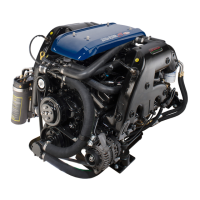57
L510032-16
OUT-OF-SEASON STORAGE - 13
CAUTION
When installing the battery, make certain that you
connect the POSITIVE (+) BATTERY CABLE to the
POSITIVE (+) BATTERY TERMINAL rst, and the
NEGATIVE (-) BATTERY CABLE to the NEGATIVE
(-) BATTERY TERMINAL last. If the battery cables
are reversed, the electrical system will be damaged.
RECOMMISSIONING AFTER STORAGE
IMPORTANT: This service should be performed by
an Authorized Crusader Challenger Marine Engines
Certied Dealer.
When recommissioning the engine after storage, the
following items should be checked:
1. Assemble the raw water pump and reinstall
on the engine.
2. Check all the cooling system hoses. Be sure
they are properly connected and all the hose
clamps are tight.
WARNING
Do not use jumper cables and/or a booster battery
to start the engine. Do not recharge a weak battery
in the boat. Remove the battery and recharge in
a ventilated area away from fuel vapors, sparks or
open ame.
3. Install the fully charged battery. Be sure
that all the connections are clean and free
from corrosion. Coat the battery terminal
connections with an anti-corrosion battery
terminal spray.
4. Readjust alternator and water pump drive belt
tension.
5. Check engine alignment.
6. Check engine and transmission oil levels.
7. Check engine mount fasteners.
8. Open the fuel shut-o valve (if equipped).
9. Refer to the OPERATING INSTRUCTIONS
section and perform all the safety checks
before starting the engine.
10. Refer to the Engine Maintenance section
and perform the Priming the Fuel System
instructions.
OUT-OF-SEASON ENGINE WARM-UP
If it is necessary to start your engine(s) during cold
weather storage, refer to the following procedure.
1. Refer to “Recommissioning After Storage” to
make certain all drain plugs, hoses, batteries and
connections are secure.
2. Start the engine(s) and idle until normal engine
oil pressure is reached.
3. Raise the engine RPM and hold at 1500 RPM
until NORMAL operating temperature is reached.
4. Raise the engine RPM again and hold at 2500
RPM. Allow the engine to run for approximately
5 minutes in order to heat up the exhaust system.
5. Return the engine to idle speed and shut the
engine “OFF.”
6. Refer to “Engine Storage” and “Draining
Instruction” to make certain the engine is fully
protected from freezing during the remaining
storage period.
Following this procedure will reduce the possibility of
condensation build up in the engine exhaust system, due
to cold weather start-ups.
CAUTION
If the engine(s) is (are) to be started prior to
launching, use the procedure FLUSHING COOLING
SYSTEM before proceeding to start the engine(s).
11. Open the seacock before starting the engine.
12. Start the engine and closely observe the
instrument panel. Allow the engine to reach
normal operating temperature. Inspect the
engine carefully for fuel, exhaust, oil and
water leaks.
13. Check the steering, shift and throttle controls
for proper operation.

